
A classical Kuiper belt object, also called a cubewano ( "QB1-o"), is a low-eccentricity Kuiper belt object (KBO) that orbits beyond Neptune and is not controlled by an orbital resonance with Neptune. Cubewanos have orbits with semi-major axes in the 40–50 AU range and, unlike Pluto, do not cross Neptune's orbit. That is, they have low-eccentricity and sometimes low-inclination orbits like the classical planets.
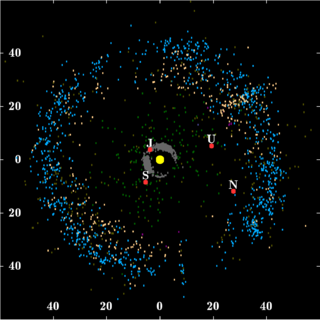
The Kuiper belt is a circumstellar disc in the outer Solar System, extending from the orbit of Neptune at 30 astronomical units (AU) to approximately 50 AU from the Sun. It is similar to the asteroid belt, but is far larger—20 times as wide and 20–200 times as massive. Like the asteroid belt, it consists mainly of small bodies or remnants from when the Solar System formed. While many asteroids are composed primarily of rock and metal, most Kuiper belt objects are composed largely of frozen volatiles, such as methane, ammonia, and water. The Kuiper belt is home to most of the objects that astronomers generally accept as dwarf planets: Orcus, Pluto, Haumea, Quaoar, and Makemake. Some of the Solar System's moons, such as Neptune's Triton and Saturn's Phoebe, may have originated in the region.

A trans-Neptunian object (TNO), also written transneptunian object, is any minor planet in the Solar System that orbits the Sun at a greater average distance than Neptune, which has a semi-major axis of 30.1 astronomical units (au).

In planetary astronomy, a centaur is a small Solar System body with either a perihelion or a semi-major axis between those of the outer planets. Centaurs generally have unstable orbits because they cross or have crossed the orbits of one or more of the giant planets; almost all their orbits have dynamic lifetimes of only a few million years, but there is one known centaur, 514107 Kaʻepaokaʻawela, which may be in a stable orbit. Centaurs typically exhibit the characteristics of both asteroids and comets. They are named after the mythological centaurs that were a mixture of horse and human. Observational bias toward large objects makes determination of the total centaur population difficult. Estimates for the number of centaurs in the Solar System more than 1 km in diameter range from as low as 44,000 to more than 10,000,000.
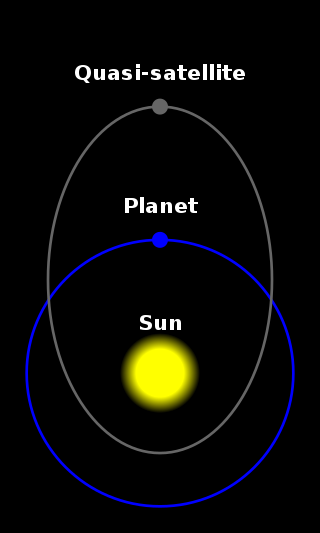
A quasi-satellite is an object in a specific type of co-orbital configuration with a planet where the object stays close to that planet over many orbital periods.
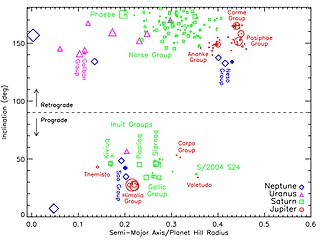
In astronomy, an irregular moon, irregular satellite or irregular natural satellite is a natural satellite following a distant, inclined, and often eccentric and retrograde orbit. They have been captured by their parent planet, unlike regular satellites, which formed in orbit around them. Irregular moons have a stable orbit, unlike temporary satellites which often have similarly irregular orbits but will eventually depart. The term does not refer to shape; Triton for example, is a round moon, but is considered irregular due to its orbit.

The formation of the Solar System began about 4.6 billion years ago with the gravitational collapse of a small part of a giant molecular cloud. Most of the collapsing mass collected in the center, forming the Sun, while the rest flattened into a protoplanetary disk out of which the planets, moons, asteroids, and other small Solar System bodies formed.
(24835) 1995 SM55, provisional designation 1995 SM55, is a trans-Neptunian object and member of the Haumea family that resides in the Kuiper belt, located in the outermost region of the Solar System. It was discovered on 19 September 1995, by American astronomer Nichole Danzl of the Spacewatch program at Kitt Peak National Observatory near Tucson, Arizona, in the United States. It measures approximately 200 kilometers in diameter and was the second-brightest known object in the Kuiper belt, after Pluto, until 1996 TO66 was discovered.

The Mars trojans are a group of trojan objects that share the orbit of the planet Mars around the Sun. They can be found around the two Lagrangian points 60° ahead of and behind Mars. The origin of the Mars trojans is not well understood. One theory suggests that they were primordial objects left over from the formation of Mars that were captured in its Lagrangian points as the Solar System was forming. However, spectral studies of the Mars trojans indicate this may not be the case. Another explanation involves asteroids chaotically wandering into the Mars Lagrangian points later in the Solar System's formation. This is also questionable considering the short dynamical lifetimes of these objects. The spectra of Eureka and two other Mars trojans indicates an olivine-rich composition. Since olivine-rich objects are rare in the asteroid belt it has been suggested that some of the Mars trojans are captured debris from a large orbit-altering impact on Mars when it encountered a planetary embryo.
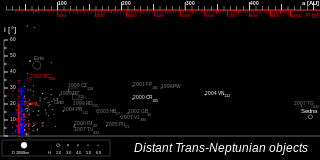
Detached objects are a dynamical class of minor planets in the outer reaches of the Solar System and belong to the broader family of trans-Neptunian objects (TNOs). These objects have orbits whose points of closest approach to the Sun (perihelion) are sufficiently distant from the gravitational influence of Neptune that they are only moderately affected by Neptune and the other known planets: This makes them appear to be "detached" from the rest of the Solar System, except for their attraction to the Sun.
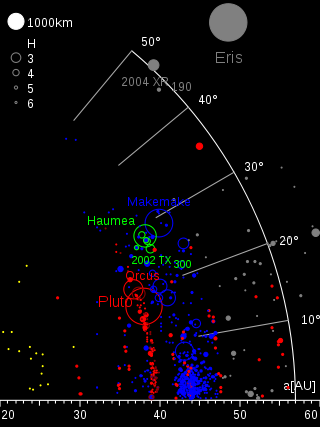
The Haumea or Haumean family is the only identified trans-Neptunian collisional family; that is, the only group of trans-Neptunian objects (TNOs) with similar orbital parameters and spectra that suggest they originated in the disruptive impact of a progenitor body. Calculations indicate that it is probably the only trans-Neptunian collisional family. Members are known as Haumeids.

The Nicemodel is a scenario for the dynamical evolution of the Solar System. It is named for the location of the Côte d'Azur Observatory—where it was initially developed in 2005—in Nice, France. It proposes the migration of the giant planets from an initial compact configuration into their present positions, long after the dissipation of the initial protoplanetary disk. In this way, it differs from earlier models of the Solar System's formation. This planetary migration is used in dynamical simulations of the Solar System to explain historical events including the Late Heavy Bombardment of the inner Solar System, the formation of the Oort cloud, and the existence of populations of small Solar System bodies such as the Kuiper belt, the Neptune and Jupiter trojans, and the numerous resonant trans-Neptunian objects dominated by Neptune.

Retrograde motion in astronomy is, in general, orbital or rotational motion of an object in the direction opposite the rotation of its primary, that is, the central object. It may also describe other motions such as precession or nutation of an object's rotational axis. Prograde or direct motion is more normal motion in the same direction as the primary rotates. However, "retrograde" and "prograde" can also refer to an object other than the primary if so described. The direction of rotation is determined by an inertial frame of reference, such as distant fixed stars.
The five-planet Nice model is a numerical model of the early Solar System that is a revised variation of the Nice model. It begins with five giant planets, the four that exist today plus an additional ice giant between Saturn and Uranus in a chain of mean-motion resonances.
The jumping-Jupiter scenario specifies an evolution of giant-planet migration described by the Nice model, in which an ice giant is scattered inward by Saturn and outward by Jupiter, causing their semi-major axes to jump, quickly separating their orbits. The jumping-Jupiter scenario was proposed by Ramon Brasser, Alessandro Morbidelli, Rodney Gomes, Kleomenis Tsiganis, and Harold Levison after their studies revealed that the smooth divergent migration of Jupiter and Saturn resulted in an inner Solar System significantly different from the current Solar System. During this migration secular resonances swept through the inner Solar System exciting the orbits of the terrestrial planets and the asteroids, leaving the planets' orbits too eccentric, and the asteroid belt with too many high-inclination objects. The jumps in the semi-major axes of Jupiter and Saturn described in the jumping-Jupiter scenario can allow these resonances to quickly cross the inner Solar System without altering orbits excessively, although the terrestrial planets remain sensitive to its passage.

2012 VP113, also known by its nickname "Biden", is a trans-Neptunian object of the sednoid population, located in the outermost reaches of the Solar System. It was first observed on 5 November 2012 by American astronomers Scott Sheppard and Chad Trujillo at the Cerro Tololo Inter-American Observatory in Chile. The discovery was announced on 26 March 2014. The object probably measures somewhere between 300 and 1000 km in diameter, possibly large enough to be a dwarf planet.
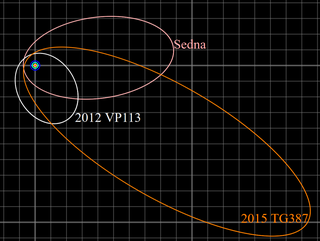
A sednoid is a trans-Neptunian object with a perihelion well beyond the Kuiper cliff at 47.8 AU. Only four objects are known from this population: 90377 Sedna, 2012 VP113, 541132 Leleākūhonua (2015 TG387), and 2021 RR205, but it is suspected that there are many more. All four have perihelia greater than 55 AU. These objects lie outside an apparently nearly empty gap in the Solar System and have no significant interaction with the planets. They are usually grouped with the detached objects. Some astronomers, such as Scott Sheppard, consider the sednoids to be inner Oort cloud objects (OCOs), though the inner Oort cloud, or Hills cloud, was originally predicted to lie beyond 2,000 AU, beyond the aphelia of the four known sednoids.

(82158) 2001 FP185, provisional designation 2001 FP185, is a highly eccentric trans-Neptunian object from the scattered disc in the outermost part of the Solar System, approximately 330 kilometers in diameter. It was discovered on 26 March 2001, by American astronomer Marc Buie at Kitt Peak National Observatory in Arizona, United States.
The hypothetical Planet Nine would modify the orbits of extreme trans-Neptunian objects via a combination of effects. On very long timescales exchanges of angular momentum with Planet Nine cause the perihelia of anti-aligned objects to rise until their precession reverses direction, maintaining their anti-alignment, and later fall, returning them to their original orbits. On shorter timescales mean-motion resonances with Planet Nine provides phase protection, which stabilizes their orbits by slightly altering the objects' semi-major axes, keeping their orbits synchronized with Planet Nine's and preventing close approaches. The inclination of Planet Nine's orbit weakens this protection, resulting in a chaotic variation of semi-major axes as objects hop between resonances. The orbital poles of the objects circle that of the Solar System's Laplace plane, which at large semi-major axes is warped toward the plane of Planet Nine's orbit, causing their poles to be clustered toward one side.














